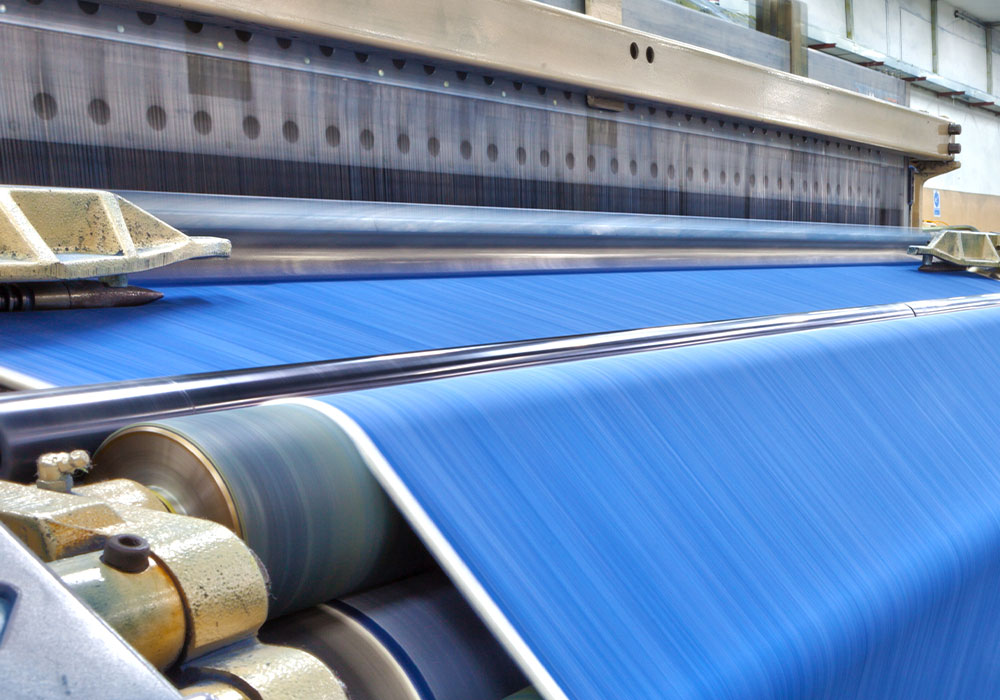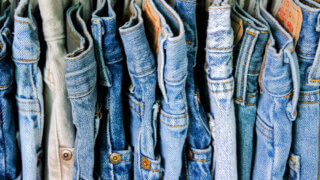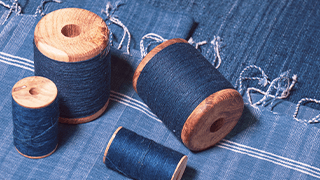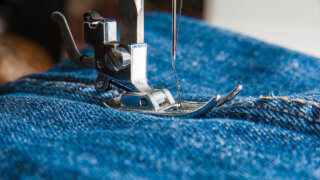Denim Weaving
Drawing-In & Warp Tying
When a new denim style is put on a weaving machine, it is necessary to draw or insert the warp yarns through various loom elements, including:
- Stop motion devices
- Weave design control devices
- Filling beat-up device
Each end of yarn must have its own individual drop wire and heddle and be inserted into the correct dent in the reed. This procedure can be done manually or automatically on drawing-in machines.

Next, each warp yarn passes through its own heddle that is suspended in the harness. The heddle has an eye through which the yarn passes and allows for exact control of each yarn. The harnesses control the raising and lowering of the warp yarns. The yarns then proceed through the dents of the reed.
The reed is a comb-like device that maintains the spacing of the warp yarns, controls the width during weaving, and performs the beating up of the filling yarn into the body of the cloth.
The point where the yarn is beaten up into the cloth is called the fell-of-the-cloth. This is the transition point where the yarn becomes fabric. The cloth now winds over the take-up roll, sometimes called the sand roll or press roll, which when combined with the let-off of the loom beam controls the number of picks per inch in the fabric.
Finally, the cloth is rolled onto a cloth roll. The threading or drawing-in of the yarns can be done manually or automatically on drawing-in machines. Of course, manual drawing-in is much more time-consuming. When the same end count and draw are to follow on a loom with a depleted warp, then a full beam of yarn can be tied to the yarns of the old beam. This can be done by the use of a tying-in machine that automatically selects an end of yarn from the old beam and ties it to the appropriate end on the new beam. This can be done very quickly with minimum loom downtime.
Yarn Flow
Warp yarns are fed from the loom beam and pass over a whip roll or rollers, which help to control variation in yarn tension during weaving. The yarns are then directed through drop wires, heddles, and a reed. The spaces between the reed wires across the width of the reed are called dents. Each reed will have a specific number of dents per inch—12 to 18 for most denim and denim-type fabrics. The reed number and the number of warp ends determine the woven width of the fabric. In denim weaving, each reed will have a specific number of dents or spaces per inch, 12 to 18 for most constructions. There are normally four warp ends drawn per dent in the standard 3 X 1 twill denim fabric.
The number of harnesses is determined by the denim weave pattern, the number of ends, and the pattern selection device on the loom. The flow of the filling yarn is somewhat simpler. The yarn is fed from large packages located outside the actual weaving machine. As the yarn comes off the packages, it is wound onto a storage feeder which accumulates the yarn under consistent tension and precise length for each pick insertion. This allows for more uniform fabric. The yarn is then introduced to the filling insertion mechanism and inserted across the separated and evenly spaced warp yarns which have formed what is called a weave shed or warp shed.
Basic Weaving Motions
Four basic motions are required to weave fabric such as denim:
- Shedding determines the design
- Filling insertion determines the range of speeds
- Beat-up pushes the inserted filling yarn into the fabric
- Warp control (let-off or take-up) determines the rate at which the fabric will be made
Shedding
Shedding is the process of creating a path across and through the warp yarns by raising some warp threads by their harnesses and by leaving other yarns down by keeping their harnesses in the down position.
There are three methods of creating a shed:
- Cam shedding is the most basic of shedding motions. It uses profiled cams to move the harnesses up and down. Cam looms usually have 6-8 harnesses. Cam looms are best suited for simple weaves like plain weaves, basic twill weaves and satin weaves. Pattern changes require changing the harness cams, which is a simple process.
- Dobby shedding uses an electronic or mechanical device to select and move individual harnesses. Up to 28 harnesses can be used to weave complex twills, satins, small geometric figures, and pattern stripes.
- Jacquard shedding is the most complex shedding system. It is named after its inventor, Joseph-Marie Jacquard, who developed this system in 1801 to be used on handlooms. The jacquard has advanced significantly since then, but it still works on the same principle today. Jacquard shedding exhibits control on each individual warp yarn independent of all other warp yarns, up to 12,000 warp ends can be controlled. These systems can employ mechanical or electronic devices to actuate the warp ends. Design capability is virtually unlimited. Pattern areas can equal the width of the fabric and are almost unlimited in the length. Fabrics made on jacquard looms are normally more expensive because of their complexity and slower weaving speed. There are no harness frames in this style of loom as each end is activated independently being controlled by its own harness cord from the jacquard head. The harness cord is attached to a heddle which is pulled down by a spring in most cases but in some of the older and slower models, weights are used to pull the heddle down to achieve the pattern.
Filling Insertion
Filling insertion involves inserting the filling yarn through the weave shed. The oldest insertion method, shuttle weaving, has almost completely been replaced by other methods such as projectile, rapier, and air-jet insertion. Most denim fabrics are woven using these modern insertion methods.
- Most air-jet machines weaving denim will insert 600-800 picks per minute.
- Projectile looms are capable of 300-500 picks per minute.
- Rapier looms can weave at 500-700 picks per minute.
A good number of old shuttle looms still produce original width and construction denim fabrics for authentic reproduction jeans to fill the need for vintage-looking denim garments.
The warp yarns pass through the reed. The reed is usually cam-driven receding backward during yarn insertion and moving forward after pick insertion. This forward motion beats each inserted pick into the fabric body.
Warp Control
The warp control (let-off or take-up) device controls the rate at which the loom beam feeds the warp yarn into the machine. Tension sensing devices will signal the let-off when more yarn is needed to maintain a consistent warp yarn tension. Fabric take-up mechanisms control the rate of removal of the fabric from the weaving machine. The faster the rate of take-up, the fewer the picks per inch inserted into the fabric. The slower the rate of take-up, the more picks per inch are inserted into the fabric. Thus, coarser and bulkier filling yarns provide more fabric cover and require fewer pick insertion, thus increasing the rate of fabric production. The woven denim fabric is then wound onto a cloth take-up roll which can be either built into the loom or located off the loom.
Most modern denim looms now have off-loom cloth take-ups due to the large batching requirements for modern denim processing. Some machines have inspection stands, allowing for easy inspection of the fabric before the cloth goes to the take-up roll. When the cloth roll has reached its maximum size, which is usually intended to coincide with the warp beam running out of yarn, the cloth is doffed and taken to the dyeing and finishing department.
TERMS TO KNOW (click to flip)
Usually a flat piece of metal with a hole or eye in it that is supported by the Harness frame…
view in glossaryA comb-like device that has warp ends drawn through it on a loom. The reed pushes the filling picks into…
view in glossaryThe point on a loom where yarns become cloth. The point of the last pick beaten up into the cloth.
view in glossaryThe roller, sometimes called the sand roll or press roll, that controls the advance of woven cloth on the loom.
view in glossaryThe process of taking warp yarns off the loom beam and pulling each end through its own Drop Wire, heddle,…
view in glossaryThe open space between the wire in a comb or reed.
view in glossaryThe area formed by the two sheets of warp yarns created when some of the harnesses are lifted and the…
view in glossaryThe process of forming the warp shed and the mechanical system that creates the shed. There are three types of…
view in glossaryThe act of inserting the filling yarn into the warp yarns to make cloth. This process will be one of…
view in glossaryThe process common to all looms where the loosely inserted filling yarn is pushed up into the fabric forming the…
view in glossaryThe function on the loom that controls the take-up of the cloth and the let-off of the warp.
view in glossary

